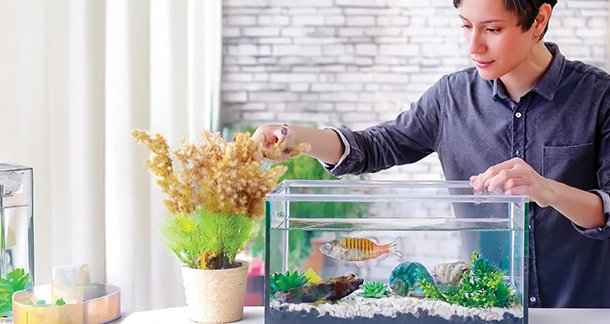India is a subtropical country where we experience multiple weather events. During summers, some of the parts of India experience temperatures as high as 42-45 degrees Celsius. During monsoon, some parts get very high rainfall along with drop in temperatures and in winters, we also see this extreme due to the effects of global warming. Now, we can even see rainfall in winters, which fluctuates the temperature more. So in these conditions, providing stable water temperatures to your aquatic pets is a must as these sudden changes can inflict diseases and reduced metabolism for them. Here are the things Aquarium owners should keep in mind:
- Maintain Stable Water Temperature
Generally, winter months in India start from November and last till the end of February. As per the topography we have seen, the temperature fluctuates. Some parts record temperatures as low as a single digit. We are not focussing on the areas where temperature drops below minus, as they have their own house insulation, but again the same guidelines can be followed by them too.
- Use a Heater/Thermostat:Rather than an aquarium heater, I would personally suggest to use an aquarium thermostat from a reputated brand which comes with warranty. A heater is not controlled. If you want temperature to be at 25c, it will not switch off automatically at 30c. So, to avoid this, please use a thermostat which has a cut off. Ideally, in most of the conditions you can keep the water temperature to
- Check the Temperature Regularly:Please use a digital thermometer to maintain the temperature regularly. Some of the situations in which the thermostat is not calibrated properly, it might show the correct temperature.
- Avoid Direct Airflow:Please avoid placing your aquarium not just in winters, but in any weather conditions in your balcony, outdoor places as in summers, direct sunlight will spike up the temperature along with inviting algae growth. In winters, again this direct exposure will spike the temperature down.
- Monitor Water Quality
Reduced temperature also have some negative effects on the biological filtration . There are research papers which have shown requirement of stronger filtration during winter season. Reduced temperature slows down the activity of beneficial bacteria which breaks down your tanks’ ammonia and nitrate:
- Increase Aeration:Lower the temperature = lower oxygen level. To reduce this, please use an additional aeration to compliment the depleted level of oxygen.
- Test Water Regularly:Test the water for vital metrics ammonia, nitrite, and nitrate levels regularly. If ammonia or nitrites are present, perform partial water changes till it is at a desired level.
- Use a Reliable Filter or Over filtration:Make sure you have a strong water filtration. If your tank size is 100lt, please use 400-500lt of water filtration. Over filtration does not kill fishes but under filtration does.
- Partial Water Changes:Conduct regular water changes like 20-25% of the volume. Please use a good dechlorinator or de-stress for the new water so your fishes do not go into shock. I use Teraa Aqua Conditioner and Teraa Stress remover for the same. Do not perform a sudden large water change as it might induce shock.
- Light and Daylight Hours
- Artificial Lighting:Ensure your aquarium receives ample amount of light. If you are using thermostat, you can go with a LED with no heat. If you are keeping a basic tank, then can use a PLL as it will provide light along with heat. If you are keeping a planted tank, then please use the light as per the lighting cycle. For normal fish tanks, morning 2-3 hours and evening same will be ideal. You can use timers to control it.
- Avoid Overheating:While it is important to provide adequate lighting, be cautious not to overheat the tank.
- Feeding Habits in Winter
During the winter months, fish metabolism tends to slow down, so overfeeding can lead to water quality issues due to excess waste. Therefore, it is important to fine tune the feeding course too:
- Feed Moderately:Feed less. Please feed what the fishes can eat in 2-3 minutes. Do not over feed. Fishes do not have the thinking capacity of their own to trigger what their intake quantity is. So, ensure to feed moderately and feed sparingly. Remove any uneaten food.
- Choose High-Quality Food:In colder months, opt for high-quality fish food that is perfectly balanced for nutrition. I use Teraa soft feed for the fishes and in some cases, I use North fin as they are made up of high quality protein.
- Observe Fish Behavior:Keep an eye on the fish to gauge their appetite. If they are eating less, do not press the panic button right away as it is normal for them to have less food consumption during the same. Look for diseases like white spot/ick and if encountered, place the fish into a hospital tank as soon as possible and start the
Conclusion
Fishes are adaptive species like us, for example if we stay 24*7 in lesser temperature, over a time frame our body starts accepting the same and starts functioning accordingly. The same happens with fishes. As we take some precautions during all kinds of weathers weathers, we need to provide the same for the fishes too. Be proactive as opposed to reactive. We use high quality feed along with probiotics+prebiotics over the year so the fishes internally also become stronger and resistant. A regular dosage of multivitamins along with their diet will take it a long way. With a good diet and above necessary steps, your fishes can thrive in winters and reward you. Happy Fish Keeping!

